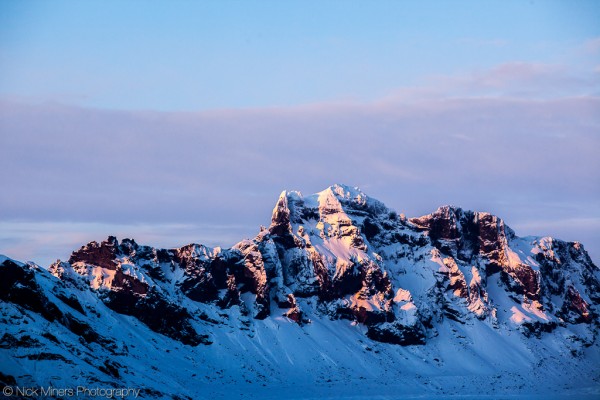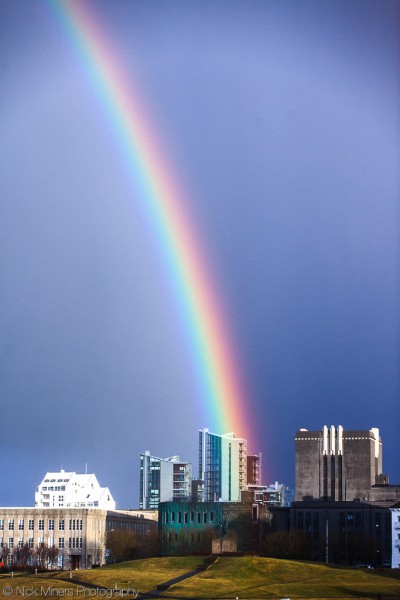Originally published at nickminers.com/blog, here is a post about the top 10 things to consider if you’re planning to visit Iceland at all.
Iceland is a bewitching country whose reach extends far beyond just those who have visited. So many people I speak to, a lot of them also photographers, have Iceland high up their list of places they want to visit, and I am often asked for advice on what people should look for when planning a trip. So in no particular order, here are ten things you should consider when planning your visit.
1. Hire a car
There are hundreds of tours operated by local companies from Reykjavík, from northern lights spotting to excursions as far as Greenland, but as good as the tours are, you are still stuck with the fixed itinerary and the crowd of people who come with you. To experience Iceland properly you need to experience the isolation, and having a car will allow you the freedom to leave as early or as late as you want, stop where you want, and return when you want.
Be very careful when driving in Iceland. Whilst the roads to the most popular places are asphalt roads, not all of them are surfaced. Some of them can be unpredictable and dangerous, and many are impassable by all but the most rugged 4×4 vehicles, so ensure you hire a car appropriate to the sort of roads you will be using, and always obey the local speed limits. Speeding fines are painfully high and the consequences of careless driving can be fatal.
2. Leave the capital
While it is possible to see a lot of what Iceland has to offer by finding a hotel or guest house in Reykjavík and driving out somewhere different each day, by booking accommodation in a farmhouse or rural guesthouse you can explore further, and also experience the local hospitality at first hand. Iceland Farm Holidays offer car hire and accommodation packages where you can pick from one of their tours or tailor-make your own.
3. Learn the language
It is true that most Icelanders speak perfect English, and enjoy the opportunity to do so. However learning a few basic Icelandic phrases, such as ‘Góðan daginn’ (Hello) and ‘Takk fyrir’ (thank you) is a great way to show courtesy to the local culture. Most guide books will contain a section with a few choice phrases that will come in handy, but if you want to delve deeper into their language and its idiosyncracies, there is a free online course at icelandiconline.is.
4. Explore the capital
Iceland is famous for its wild scenery and vast open spaces, but also for its nightlife. Reykjavík is a vibrant, compact city with plenty of variety. During the day time you can visit one of the many museums, from the National Gallery (Listasafn Íslands) and the Art Museum (Listasafn Reykjavíkur) to the more special interest Phallological Museum. The view from the top of the tower at Hallgrímur’s church (Hallgrímsirkja) is very impressive, as is that from Perlan (the Pearl), a glass-domed public space built on top of six hot water tanks to the south of the city centre. The newly finished concert hall Harpa is a wonder of modern architecture and well worth a visit, at night as well as during the day (you’ll see why!). Even if you’re not attending a concert, you can relax in the cafe or browse the record shop, and take advantage of free Wi-Fi, something that is common throughout Reykjavík.
At weekends, the flea market Kolaportið opens where you can browse through hundreds of stalls selling food, arts and crafts, music, and knitwear.
Late at night the bars become very busy, and though the beer is not cheap, you don’t need to get hammered to have a great time as the atmosphere is invariably friendly. There are no night clubs as such but plenty of bars have live music – check the listings at the Reykjavík Grapevine to see what’s on. Be prepared to stay up as late as 4am if necessary!
5. Take to the sky
Iceland from above is like no other place I know. I was fortunate enough to be able to hire a local pilot on my last visit and got some spectacular views on a beautiful clear winter day. There are various companies who offer aerial photography or sightseeing tours – all are definitely worth checking out. In Reykjavík you have Eagle Air, Eyjaflug and Atlantsflug, while further north at Mývatn there is Mýflug.
6. Eat on a budget
Like pretty much everything else, the food in Iceland is expensive. Eating out is a luxury most tourists can’t really afford to do every day, though there are cheap places you can go. Top of your list should be Bæjarins Bestu Pylsur (‘the town’s best hot dogs’) which is a small hot dog stand which serves the best hot dogs in Iceland, and possibly the world. Ask for ‘eina með öllu’/’one with everything’ (or two if you’re particularly hungry) and enjoy food fit for a president – Bill Clinton is a famous past customer.
Hamborgarabullan on Geirsgata is a hamburger restaurant which offers well priced and very tasty hamburgers and chips. You won’t find McDonalds or Burger King anywhere in Iceland, but after trying Hamborgarabullan’s food you won’t want to.
Hlöllabátar is a subway sandwich shop in Ingolfstorg which will fill you up without emptying your wallet. But for food on the go, your best bet is to visit one of the supermarkets (Bónus or Krónan) and buy some bread, cheese, coleslaw or other sandwich fillings and make your own picnic. Be sure to buy some pots of Skyr too – a dairy product like a cross between yoghurt and cream cheese that comes in several flavours.
If you’re on the road, most service stations in the larger towns you visit will have similar food for sale so you can top up on provisions.
7. Make the most of the time of year
Iceland can be enjoyed at any time of year as each season has its own charms. In summer the weather is milder than you’d expect at these latitudes, as the atlantic gulf stream carries warm air from the Caribbean meaning you can expect temperatures in double figures (celsius). The days are very long, often with only a few hours’ twilight between sunset and sunrise, though even this is shorter in the north of the country. If you want to see the aurora, this would not be the time to visit. However many of the less-accessible parts of Iceland, such as Landmannalaugar, are only open in the summer.
In winter the temperature drops below zero but the wind can make it feel much colder, so you will need to wrap up warm. The sun doesn’t make much of an appearance, but when it does, it has a beautiful golden colour as it stays very close to the horizon, casting long shadows. The air on a good day can be very crisp and refreshing, and of course the long nights mean you have your best chance of seeing the aurora. Roads outside urban areas can become treacherous though, even the asphalt main roads, so check before travelling at the website of the Icelandic Road Administration.
The day length still varies considerably throughout spring and autumn, but due to Iceland’s western location you get more light in the evenings than in the mornings, as they use GMT all year round. Weather-wise you can and should expect anything, from winds that can lift a person off their feet to clear blue skies, at any time of year.
8. Go native
Iceland is famous for its more unusual foodstuffs. Apart from whale and puffin which are served in many local restaurants, you can buy dried fish (harðfiskur) and fermented shark (hákarl) from most supermarkets, as well as the more accessible smoked lamb (hangikjöt) which is served in flatbread (flatkaka). If you ever find yourself at a loose end at the BSÍ bus terminal, the cafe there also serves Svið – boiled sheep’s head.
Of the liquid variety, Brennivín (literally, ‘burning wine’) is the local Schnapps which is often used to wash down hákarl. There are plenty of local microbreweries that offer alternatives to the ubiquitous Egill’s Gull and Víking beers – I personally recommend Einstök and Jökull beer (EDIT: turns out Jökull beer is no longer brewed).
9. Get on the Airwaves
Every year, at the end of October, Reykjavík plays host to the Iceland Airwaves music festival. What started as a one-off show in an aircraft hanger in 1999 has evolved into one of Europe’s biggest and most popular music festivals, hosting hundreds and hundreds of events in venues across the city, from the vast Silfurberg hall in Harpa, to a tiny mobile hut in Ingolfstorg with room for an audience of three. Iceland’s own thriving music scene is always well represented, but the event also features new bands from across the world, as well as the occasional unexpected special guest.
For just under a week the town fills with music fans from across the globe, and the atmosphere throughout is like one huge non-stop party. Even if you don’t manage to get a ticket for the festival itself, the off-venue concerts held in cafes, bookshops and hostels are all free of charge and feature many, if not most, of the headline acts. But make sure you arrive early – these places fill up very quickly.
10. Let go
Everyone who goes to Iceland will have their own expectations and lists of places to see. The best known sights—Gullfoss, Geysir, the Blue Lagoon, Jökulsárlón—are all well worth a visit, and should not be missed. However I often find that the more memorable moments come unexpectedly. Ask a local for ideas on what to do that most people wouldn’t consider, take a detour down a side road (ensuring first that it is suitable for whatever vehicle you are in)–try something unexpected and you may just find something special that you can keep as your own little secret part of Iceland.
Góða ferð!
Nick




